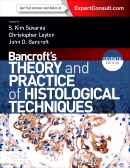|
|
|
| |
 |
|
|

|
 推薦指數:
推薦指數:





|
|
- 內容介紹
|
Bancroft's Theory and Practice of Histological Techniques, 7th Edition
Expert Consult: Online and PrintBy Kim S Suvarna, MBBS, BSc, FRCP, FRCPath, Christopher Layton, PhD and John D. Bancroft
Hardcover
Reference
576 Pages
Trim Size: 7 7/16 X 9 11/16 in
Imprint: Churchill Livingstone
ISBN: 978-0-7020-4226-3
Copyright: 2013
This is a brand new edition of the leading reference work on histological techniques. It is an essential and invaluable resource suited to all those involved with histological preparations and applications, from the student to the highly experienced laboratory professional. This is a one stop reference book that the trainee histotechnologist can purchase at the beginning of his career and which will remain valuable to him as he increasingly gains experience in daily practice.
New to This Edition
Brand new co-editor.
Online self assessment questions and answers. Will help reinforce all of the basics in order to pass course exams, professional certification exams.
New material on immunohistochemical and molecular diagnostic techniques.Enables user to keep abreast of latest advances in the field.
.Key Features
Thoroughly revised and up-dated edition of the standard reference work in histotechnology that successfully integrates both theory and practice.Provides a single comprehensive resource on the tried and tested investigative techniques as well as coverage of the latest technical developments.
Over 30 international expert contributors all of whom are involved in teaching, research and practice.Provides authoritative guidance on principles and practice of fixation and staining.
Extensive use of summary tables, charts and boxes.Information is well set out and easy to retrieve.
Six useful appendices included (SI units, solution preparation, specimen mounting, solubility). Provides practical information on measurements, preparation solutions that are used in daily laboratory practice.
Color photomicrographs used extensively throughout. Better replicates the actual appearance of the specimen under the microscope.
.
|
|
|

